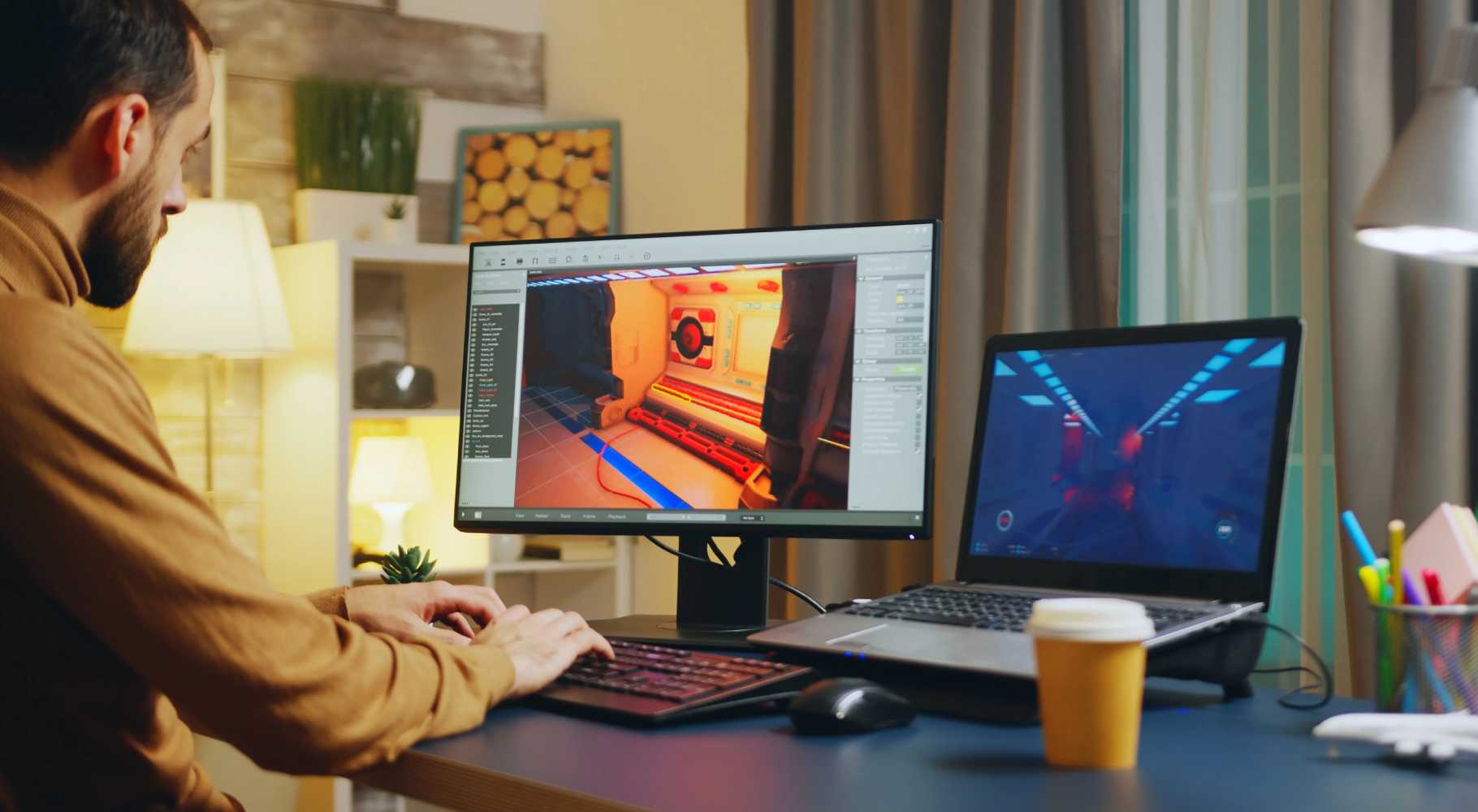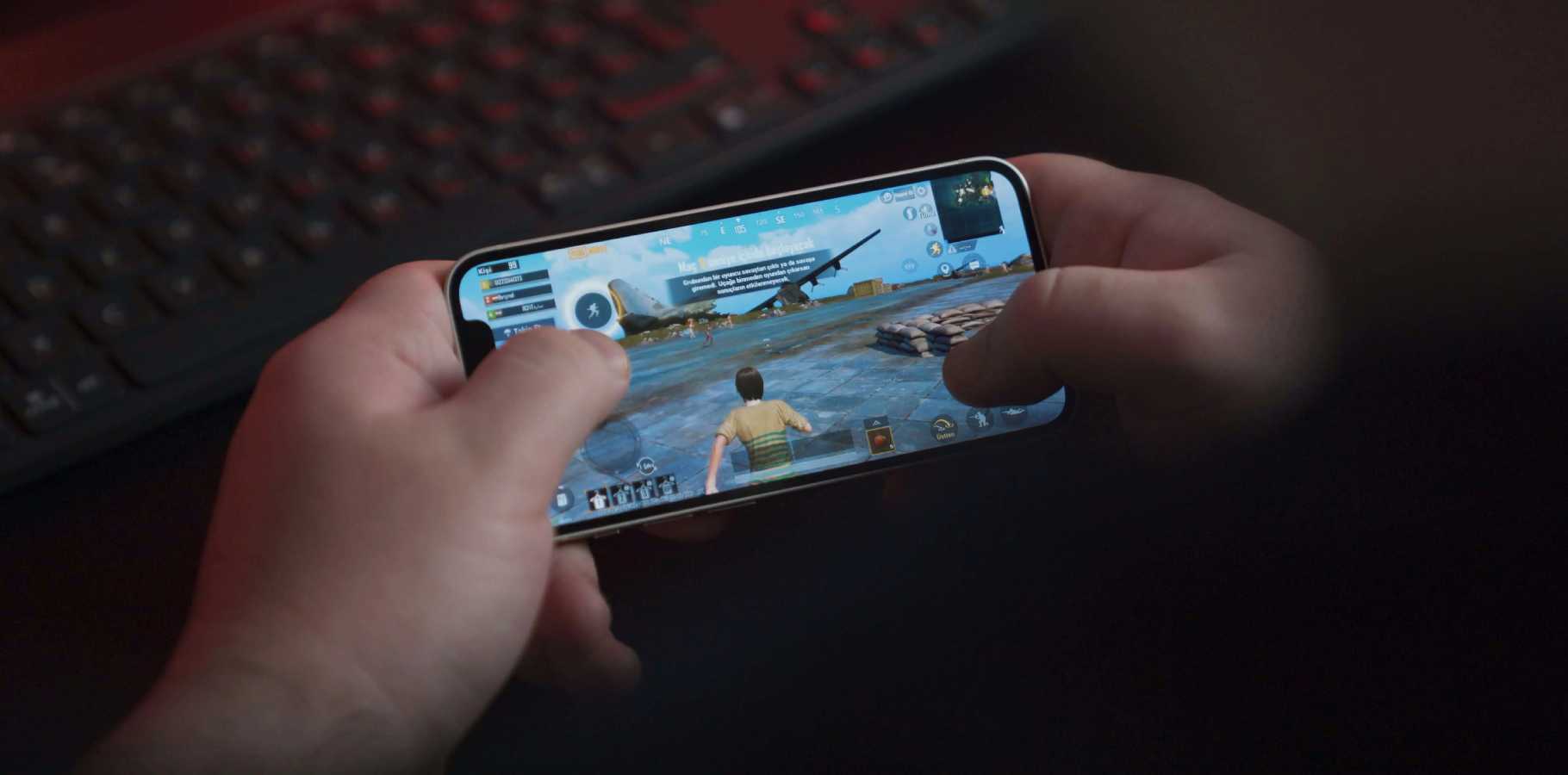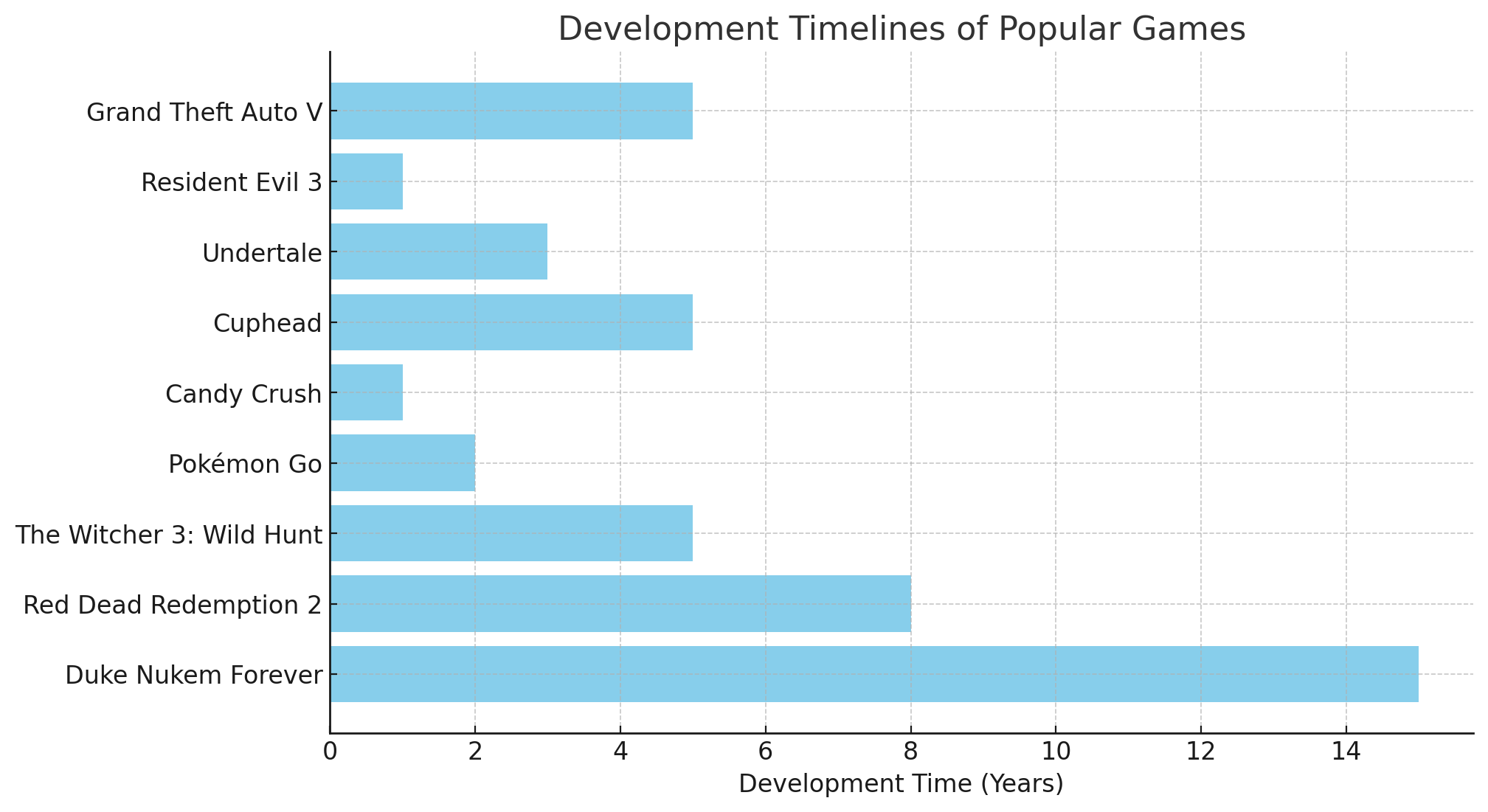From indie darlings to AAA blockbusters, game development is as mixed as the games themselves. But one question resounds through dev studios big and small: “How long does it take to make a game?” The answer? It differs from game to game. Some games sprint from concept to launch in a week, while others take up a decade-long journey. A great example is Duke Nukem Forever, the game that took around fifteen years to reach its course, compared to the seven-day development of Superhot.
When planning your game development, having an estimation of the timeline can be a real head-scratcher. To calculate the average development time, it’s vital to consider the various stages involved in the process, from initial concept to final launch. This blog will help you understand the stages and navigate the complexities of game development.
Understanding the elements influencing game development time is crucial for effective project planning. Below, we explore the key factors that can significantly impact how long it takes to make a game and bring it from concept to completion.
Making video games involves various components, and the complexity of the game’s visuals, ranging from 2D-pixel art to highly detailed 3D graphics, significantly impacts development time. Open-world MMORPG games, for instance, require extensive environmental art and character models compared to other games.

In AAA titles, the demands on artists escalate due to the sophisticated game mechanics and physics. A prime example is The Witcher 3: Wild Hunt, where character artists painstakingly crafted numerous character models and detailed environments to reflect a rich, immersive world. This level of detail requires significant time and artistic effort, making the art creation phase a critical component of the overall development process.
Following art creation, programming is another time-intensive aspect of game development. As senior software engineer Steve Baker aptly notes, how to develop a video game efficiently often hinges on the coding process. Video game programming is among the most challenging endeavors in the field. Efficient coding practices and regular testing are essential for smooth development and minimizing performance issues that could delay a game’s launch.
The complexity of the game heavily influences the volume of code required. For example, Grand Theft Auto V is calculated to contain around 100 million lines of code, mainly written in C++. On the other hand, the rise of no-code and low-code technologies has introduced new possibilities, allowing developers to make video games with minimal coding. A notable example is Untitled Goose Game, developed using Unity without traditional coding methods. However, for games that require advanced features, coding remains indispensable.
Games with deep narratives and intricate storytelling may require additional writing, voice acting, and cutscene development time. This complexity necessitates collaboration among writers, designers, and voice actors to ensure a cohesive experience. Furthermore, extensive narrative development often leads to more detailed character arcs and engaging plot twists, enhancing player immersion.
The creation of sound effects can range from a day to several months, depending on the game’s audio requirements. Sound artists often spend significant time in studios, recording unique soundtracks and realistic soundscapes, from footsteps to explosive action, to enhance the game’s immersion.

In open-world AAA games, the diversity and detail of sound effects become even more pronounced. For example, the Grand Theft Auto series features an array of environmental and character sounds, including weapons and vehicles. Producing these realistic audio elements can add several months to development, particularly when navigating copyright laws. Complex titles like Red Dead Redemption 2 illustrate this challenge, with their extensive audio elements contributing to an eight-year development timeline. Moreover, legal disputes over unauthorized sound effects, as seen with the Call of Duty series, can further delay production.
While a larger team can facilitate faster development, that team’s efficiency hinges on its members’ expertise. Specialized and well-coordinated teams are essential to maintain the speed and quality of video game creation. A well-balanced team with specialized roles—artists, coders, designers—can help make a video game more efficient, but everyone must work harmoniously. When looking to expand, hiring game developers who can seamlessly integrate into the existing team dynamic is crucial to ensure quality production.
The expertise and efficiency of individual team members can significantly impact the speed and quality of work. The more hands-on deck can be beneficial, but team members’ skill levels and coordination play a critical role in meeting deadlines, especially for larger projects. This becomes especially important when deciding how to develop a game that meets high industry standards within tight timeframes. For projects requiring a specific artistic touch, hiring game designers who can bring creative visions to life efficiently is equally important.
The choice of game engine and development tools can significantly affect the development speed. Familiarity with these technologies enhances efficiency, making it vital to consider the tools needed to make video games effectively. Whether you are learning to make a video game using Unity, Unreal, or other platforms, the right combination of tools and adequate funding can streamline development.
Copyright infringement or other legal matters can delay development. Additionally, technical difficulties, changes in scope, or team turnover can disrupt the timeline.
Game development can be broken down into several critical phases, each contributing to the project’s timeline.
| Phase | Duration | Description |
| Conceptualization | Weeks to a few months | Focuses on brainstorming ideas, defining the core concept, and drafting the Game Design Document (GDD). Typically, it lasts 1 to 2 months for more minor games. |
| Pre-Production | Several weeks to a year | Solidifies design elements and technical requirements, planning the game’s structure and defining mechanics. |
| Production (Development and Art Creation) | Months to years | The most intensive phase, taking 2 to 3 years for medium to large-scale games, involves asset creation and coding gameplay mechanics. |
| Quality Assurance (QA) | Weeks to months | Focuses on identifying and fixing bugs, optimizing performance, and fine-tuning gameplay to ensure readiness for launch. |
| Launch | Days to weeks | Involves final preparations for release, including distribution decisions and marketing efforts. |
| Post-release Maintenance | Ongoing | Includes bug fixes, patches, and updates based on player feedback, along with developing additional content to keep the game engaging. |

Mobile games, designed for small and thin screens, typically encompass casual and mid-level games that prioritize simple mechanics, physics, and controls. This streamlined approach often leads to shorter development timelines. Generally, mobile games take between three to nine months to develop. Candy Crush took nearly a year to create. They had a dedicated team of around 25 developers, artists, designers, and producers. Other notable examples include Pokémon Go, which required about two years to develop, and Temple Run, which was completed in four months.
AAA games represent big-budget projects where producers invest millions in crafting complex game mechanics, physics, artwork, and graphics. Consequently, these games demand significantly more time to develop than their counterparts. Generally, Video games/ AAA games take approximately three to seven years to complete, though some may require even longer, depending on the game’s intricacies.
It’s interesting to note that a few AAA titles have been created in under a year because of the large teams working collaboratively. For example, Resident Evil 3 was built relatively quickly within a year by reusing some assets and technologies from Resident Evil 2. The development team adapted the original game’s design and structure from Resident Evil 3: Nemesis (1999) and modernized it, which changed the time.
On the other hand, Red Dead Redemption 2, an open-world action-adventure game, took around eight years to develop. Upon its release, the long wait proved fruitful, as it welcomed praise for its interesting storyline, attention to detail, and immersive open-world experience.
According to Matt Booty, the head of Xbox Studios, the era of big-budget games completed in two to three years is now over. He says that the average AAA game development time would normally require five to seven years due to the increased complexity of modern games and the need for advanced graphics and lighting. Furthermore, AAA games are no longer exclusive to a single platform; they are now developed for multiple platforms, including consoles, PCs, tablets, and mobile devices.
Calculating the average development time for indie games is tricky, as these projects are often passion-driven, drafted part-time, or by a single independent developer. The timeline can vary greatly based on the developer’s experience and the game’s scope. Indie developers usually work with tight budgets, and those working alone may find their projects taking considerably longer.
On one end of the spectrum, simple indie games can be created within a few months, while more ambitious projects might take three to four years to complete. Notable examples highlight this variability: Cuphead took five years for its base game and another four years for its DLC, whereas Undertale, primarily developed by Toby Fox, was completed in three years. In a remarkable feat, All You Can Take was created in just two weeks for a game jam.
Unfortunately, many indie projects are abandoned midway through development, underscoring the importance of completing game production regardless of the time taken. Nevertheless, several games developed quickly during game jam events have achieved notable success in the gaming market. For instance, Celeste emerged from a four-day game jam and became a celebrated indie title.

A Game Jam is an event where game developers come together to create a game from scratch within a limited timeframe; it ranges from a single day to several days. Renowned game jam events include Ludum Dare, Global Game Jam, and Nordic Game Jam. Many successful indie games have arisen from these events, including Don’t Starve, Inscription, and TowerFall. Game jams inflict strict time limits, encouraging developers to push their creative boundaries and explore innovative ideas. A Game Jam’s time pressure and collaborative atmosphere are the perfect stimuli for innovation and imagination.

Development hell is when a project gets mired in the planning or production phase for months or even years with no release. This can happen for a multitude of reasons:
To avoid these pitfalls and successfully navigate the challenges of development hell, it’s essential to understand how to develop a video game effectively and ensure the project remains on track.
Reducing game development time can be beneficial, but maintaining quality is crucial. Here are some effective strategies to streamline development:
Selecting the right game engine, such as Unity or Unreal Engine, can significantly reduce development time, especially for indie and mobile games. Additionally, assembling a skilled team and ensuring clear communication across all departments are vital for optimizing the development process. By applying these strategies, developers can learn how to make a video game while maintaining high-quality standards.
At Juego, we specialize in crafting immersive and engaging gaming experiences that captivate audiences worldwide. We provide various services, including mobile game development services, PC & console game development services, AAA game development services, and many more.
With a team of talented developers, artists, and designers, Juego Studios is one of the leading companies providing end-to-end game development services for more than ten years.
The journey of game development is as mixed as the games themselves. Understanding the factors influencing development time is important for creating a successful title. From the complexities of game art and programming to sound design and team dynamics, each element plays a key role in shaping the development timeline. By addressing these factors and planning effectively, developers can answer how long it takes to make a game and steerthe challenges of game creation, ultimately bringing their visions to life more efficiently.
If you’re looking to collaborate with skilled professionals, working with the proper gaming development companies can enhance the quality of your project and bring your vision to life more efficiently.
Video game development timelines vary greatly based on type and scope. Simple mobile games may take 3-6 months, while indie projects typically need 1-3 years. AAA video games require 3-7 years on average. Key factors affecting timelines include:
The development of video games has evolved significantly. Today’s tools make some aspects faster, but rising quality expectations often extend timelines. For reference, Stardew Valley (indie) took 4 years with one developer, while Cyberpunk 2077 (AAA) needed 8+ years with hundreds of team members.
Every video game development timeline follows a structured path from idea to release. The stages of game development begin with the concept phase, which typically takes 1-3 months. During this time, developers brainstorm ideas, define core gameplay, identify target audiences, and estimate initial budgets. Next comes pre-production, lasting 2-6 months, where teams create detailed design documents, plan technical requirements, establish art styles, and build early prototypes.
The production phase is the longest, requiring 6-36 months depending on scope. This is when full asset creation, programming, and level design happen alongside regular testing cycles. Before launch, games enter a dedicated testing period of 2-6 months for bug fixing, gameplay balancing, and performance optimization. The final stage includes launch preparations and Live Games support with updates and community engagement. These stages often overlap in modern development, with many studios using agile methodologies to adapt throughout the process. The complete development of video games requires careful management of each stage to maintain quality and timelines.
Game art is crucial to video games creation, serving as your product’s visual identity. Good art creates immersion and emotional connection, while poor visuals can break player engagement regardless of gameplay quality.
Art production typically consumes 30-40% of development resources. The investment varies by game type:
| Game Type | Art Team Size | Development Time | Art Budget % |
| Mobile | 2-5 artists | 3-6 months | 25-35% |
| Indie | 1-10 artists | 6-24 months | 30-40% |
| AA | 10-50 artists | 18-36 months | 35-45% |
| AAA | 50-200+ artists | 3-7 years | 40-50% |
Art pipeline planning should start early in development. Many studios outsource specific art tasks to reduce costs while maintaining quality. Remember that art revisions are inevitable and should be factored into your video game development timeline.
When you make video games, choosing the right programming language is essential. The most widely used options include:
Popular Game Programming Languages:
Your choice depends on your project needs, team skills, and selected engine. Many successful games combine multiple languages—using C++ for performance-critical systems while implementing game logic in languages like C# or Lua.
For beginners learning to make video games, starting with C# (Unity) or Blueprint visual scripting (Unreal) provides the gentlest learning curve while maintaining professional capabilities.
Yes! Developing a game has become more accessible thanks to no-code and low-code tools. You can create games without extensive programming knowledge through:
Visual Scripting Tools:
Complete No-Code Platforms:
These tools let you focus on game design rather than technical implementation. However, understanding basic programming concepts still helps when troubleshooting or creating custom features. The complexity of games you can make without coding varies:
| Game Type | No-Code Viability | Limitations |
| Puzzle/2D | Excellent | Few limitations for most concepts |
| Mobile Casual | Very Good | May need plugins for monetization |
| Action/Platformer | Good | Complex physics might require code |
| RPG | Moderate | Custom systems may need coding |
| Open World/MMO | Limited | Typically requires programming |
For serious developers, learning at least basic coding eventually becomes valuable for the development of video games with unique features.